
T
ẠP CHÍ KHOA HỌC
TRƯ
ỜNG ĐẠI HỌC SƯ PHẠM TP HỒ CHÍ MINH
Tập 21, Số 6 (2024): 985-997
HO CHI MINH CITY UNIVERSITY OF EDUCATION
JOURNAL OF SCIENCE
Vol. 21, No. 6 (2024): 985-997
ISSN:
2734-9918
Websit
e: https://journal.hcmue.edu.vn https://doi.org/10.54607/hcmue.js.21.6.3961(2024)
985
Research Article1
ON THE COMPARISON OF ISHIKAWA-TYPE ITERATIVE PROCESSES
FOR CONTRACTION MAPPINGS IN BANACH SPACES WITH GRAPHS
Nguyen Tien Khai, Nguyen Tan Phuc, Nguyen Thai Hung*,
Nguyen Cong Duy Nguyen, Huynh Trung Hieu1
Ho Chi Minh City University of Education, Vietnam
*Corresponding author: Nguyen Thai Hung – Email: thaihungspt2003@gmail.com
Ngày nhận bài: 15-9-2023; ngày nhận bài sửa: 26-10-2023; ngày duyệt đăng: 30-10-2023
ABSTRACT
Numerous studies have examined the convergence of iterative processes with graphs to a
common fixed point of contraction mappings. However, research comparing the convergence rates
of these processes remains limited. This paper addresses this gap by analyzing the convergence rates
of several Ishikawa-type iterative processes to a common fixed point of contraction mappings in
Banach spaces with graphs. We propose sufficient conditions to determine the relative speed of
convergence between iteration processes. Our work extends recent findings on the comparison of
convergence rates between two-step and three-step iteration sequences, offering improved parameter
range assumptions. Notably, this study introduces a novel approach to formulating optimal
hypotheses for comparing convergence rates of general iterative processes.
Keywords: Banach spaces with graphs; contraction mappings; convergence rate; Ishikawa-
type iterative processes
1. Introduction
Fixed point theory has been a subject of mathematical inquiry for approximately a
century and continues to attract significant attention from contemporary mathematicians.
One of the basic results in this theory is the Banach contraction principle, which confirms
the existence of the unique fixed point
p∈
of a contraction mapping
:T→
with a
non-empty complete metric space
( , ).d
Furthermore, this fixed point can be approximated
by the following Picard iterative sequence
1
1
,
( ), 1.
nn
u
u Tu n
+
∈
= ≥
(1.1)
Cite this article as: Nguyen Tien Khai, Nguyen Tan Phuc, Nguyen Thai Hung, Nguyen Cong Duy Nguyen, &
Huynh Trung Hieu (2024). On the comparison of Ishikawa-type iterative processes for contraction mappings in
Banach spaces with graphs. Ho Chi Minh City University of Education Journal of Science, 21(6), 985-997.

HCMUE Journal of Science
Nguyen Tien Khai et al.
986
More precisely, if
T
admits the contraction coefficient
[0,1)
α
∈
(i.e.
( ( ), ( )) ( , )dT x T y dxy
α
≤
for every
,xy∈
) then one can prove that this sequence
converges to a fixed point
p∈
with the error upper bound as below
11
( , ) ( , ), for every 1.
n
n
du p du p n
α
+
≤≥
We remind that the Banach contraction mapping principle can be stated in the special case when
in (1.1) is replaced by a non-empty convex set in Banach spaces. This theory is strongly
developed and then applied in many fields such as functional analysis and partial differential
equations. However, in many applications, it may not be possible to construct a Picard iterative
sequence corresponding to a contraction mapping
T
as in (1.1). To overcome this difficulty, it
is necessary to consider several different iterative processes which may be more complicated
than the Picard sequence in (1.1). One of the first iterative sequences to be improved was the
Mann iterative sequence in Dotson (1970) and Mann (1953), defined by
1
1
,
(1 ) ( ), 1.
n nn n n
u
u a u aT u n
+
∈Ω
=−+ ≥
(1.2)
Here we assume that the contraction mapping
T
from
Ω
into itself, where
Ω
is a non-
empty convex set in the given Banach space
( , ).⋅‖‖
Moreover, the real parameter
sequences
1
()
nn
a
≥
belongs to the interval [0,1]. Then, a new problem that arises is to compare
the convergence rates between the Mann iteration (1.2) and the Picard iteration (1.1). More
information about this is a study by Berinde (2004). For the same reason, more and more
iterative sequences with two or three-step iterations are being investigated. The first two-
step iteration was introduced by Ishikawa (1974) and Kalinde and Rhoades (1992) with the
convergence of the following procedure being studied:
( )
1
1
,
(1 ) (1 ) ( ) , 1,
n nn n nn n n
u
u a u aT b u bT u n
+
∈Ω
=−+ −+ ≥
(1.3)
It is well-known as the Ishikawa iteration, where
1
( ) [0,1].
nn
b
≥
⊂
This sequence was then
modified by replacing
T
in (1.3) by two contraction mappings
12
,TT
at two different steps
respectively. There are several ways to modify the Ishikawa iteration. For instance, Tripak,
(2016) considered the following iteration:
1
1
12
,
(1 ) ( ),
(1 ) ( ), 1.
n nn n n
n nn n n
u
v b u bT u
u a u aT v n
+
∈Ω
=−+
=−+ ≥
(1.4)
Then, other authors studied two generalized types of the Ishikawa iteration as

HCMUE Journal of Science
Vol. 21, No. 6 (2024): 985-997
987
1
1
1 12
,
(1 ) ( ),
(1 ) ( ) ( ), 1
n nn n n
n n n nn
u
v b u bT u
u a T u aT v n
+
∈Ω
=−+
=−+ ≥
(1.5)
in a study by Suparatulatorn et al. (2018), and
1
1
1 12
,
(1 ) ( ),
(1 )() (), 1,
n nn n n
n n n nn
u
v b u bT u
u a T v aT v n
+
∈Ω
=−+
=−+ ≥
(1.6)
in another study by Thianwan and Yambangwai (2019). It is worth mentioning that these
iterative processes were considered by Aleomraninejad et al. (2012) and Jachymski (2008)
for
-contractive and
-nonexpansive mappings in the Banach space
with a directed
graph
. Recently, Nguyen and Nguyen (2020) investigated the convergence of the iteration
(1.6) to the common fixed point of two mappings
12
,TT
. On the other hand, they also
proposed sufficient conditions on the parameter sequences
( )
n
a
and
( )
n
b
so that the
iterations in (1.5) and (1.6) converge faster than the previous iterative sequence in (1.4). We
now describe in detail the results related to this comparison. Let us assume that p is a
common fixed point of two contraction mappings
12
,TT
with the contraction factors
12
, [0,1)
αα
∈
respectively. Under the following assumptions
12
1
0 , for max{ , }, and 0 1,
1
nn
ab
α
ε δ α αα
α
−
<≤ ≤< = ≤ ≤
+
(1.7)
Nguyen and Nguyen (2020) proved that both iterations in (1.5) and (1.6) converge faster
than the previous one in (1.4). In the present paper, we prove that this result still holds under
some weaker assumptions than (1.7). In particular, we will replace assumptions in (1.7) by
large ranges of
( )
n
a
and
( )
n
b
as below
0 and 1,
nn
ab
ε δλ
<≤ ≤ ≤ ≤
(1.8)
for some ε > 0,
[0,1]
λ
∈
and suitable values of
δ
. For example, under the following
additional assumption
11
21 1
1 (1 ) ,
1 (2 )(1 )
α λ αλ
δα α λ αλ
− −+
<+ − −+
(1.9)
we show that the sequence (1.6) converges faster than (1.4) and the sequence (1.5) if provided
1
12 1
1.
1 2 (1 )
α
δα α λ αλ
−
<− + −+
(1.10)
These results are stated in detail in Theorem 3.2. We emphasize that both upper bounds in
(1.9) and (1.10) are strictly bigger than
1
1
α
α
−
+
in many situations of given coefficients
12
,,
λα α
. Actually, our results are new even in the special case
0
λ
=
, since

HCMUE Journal of Science
Nguyen Tien Khai et al.
988
1
12
11,
1 21
αα
αα α
−−
>
−+ +
whenever
12
αα
≠
. In other words, our results under assumptions (1.9) or (1.10) are non-
trivial improvements with respect to the results by Nguyen and Nguyen (2020) under
assumptions (1.7). Similarly, we next improve the similar results by Nguyen and Nguyen
(2020) for the three-step iterative processes.
In numerical analysis, iterative processes are employed to compute fixed points of functions,
which have diverse applications in science and engineering. A primary objective in
enhancing the convergence rates of these iteration sequences to fixed points is to optimize
computational efficiency and improve the precision of results. Using graphs in studying the
convergence rates of iteration sequences has been applied in many recent studies (Nguyen
& Nguyen, 2020; Tripak, 2016; Thianwan & Yambangwai, 2019). They show a visual
representation of the convergence rates of these sequences. By performing calculations for
specific sequences, researchers have generated corresponding graphs, enabling objective
predictions about convergence rates based on these visual representations. Moreover, these
graphs have been utilized as empirical evidence to support comparisons of convergence
rates. A notable example is found in [8, Example 3.7], where the authors employed graphical
illustrations to compare the convergence rates among several three-step iterative processes.
This approach served as the inspiration for our current investigation into this topic.
The method employed in this study relies on relatively elementary calculations, focusing on
more precise estimations of the upper bounds established by Nguyen and Nguyen (2020).
The significant aspect of this approach lies in its potential to generate novel concepts for
constructing optimal upper and lower bounds. These bounds, in turn, facilitate the derivation
of comparative results regarding the convergence rates of iterative processes. In fact, we
believe that if one can find optimal bounds depending on
( )
n
a
and
( )
n
b
then one can relax
the constraints
[, ]
n
a
εδ
∈
and
[ ,1]
n
b
λ
∈
in (1.8). We will discuss this point in the future
works.
The paper is structured as follows: Section 2 introduces key notations and definitions of
contraction mappings with graphs, which are utilized throughout the study. Sections 3 and 4
present the main theorems, along with detailed proofs and discussions of the principal
findings. The final section offers conclusions and outlines potential avenues for future
research.
2. Notation and basic definitions
We first recall some well-known definitions by Jachymski (2008) and Nguyen and
Nguyen (2020). Let
Ω
be a non-empty subset of a Banach space
(, )⋅‖‖
and
Ω
∆
denote
the diagonal of the Cartesian product
,Ω×Ω
that means
{( , ) : }.uu u
Ω
∆ = ∈Ω

HCMUE Journal of Science
Vol. 21, No. 6 (2024): 985-997
989
Consider a directed graph
such that the set
V
of its vertices coincides with
,Ω
and the
set
E
of its edges contains all loops, i.e.,
V= Ω
and
E
Ω
⊇∆
. We assume
has no
parallel edges, so we can identify
with the pair
( , ).VE
Moreover, we assume that
E
is coordinate-convex, which means
( , (1 ) ) and ((1 ) , ) ,p t u tv E t u tv p E−+∈ −+ ∈
for every
( , ),( , ),( , ),( , )pu pv u p v p E∈
, and
[0,1]t∈
.
Definition 2.1. Let us consider a mapping
:.TΩ→Ω
i) We say that
T
preserves edges of
if
( ( ), ( ))Tu Tv E∈
for every
(,)uv E∈
.
ii) The mapping
T
is said to be
-nonexpansive if there exists
[0,1]
α
∈
such that
( ) ( ) , for all ( , ) .Tu Tv u v uv E
α
− ≤− ∈
‖ ‖‖ ‖
(2.1)
In this case,
α
is called the
-nonexpansive factor of
T
. Moreover, if (2.1) holds for some
1
α
<
, we say that
T
is a
-contraction with a contraction factor
α
.
Definition 2.2. Let
( )
n
u
and
()
n
x
be two sequences in
Ω
. Assume that both sequences
( )
n
u
and
()
n
x
converge to
p
in
. We say that
( )
n
u
converges to
p
faster than
()
n
x
if
lim 0.
n
nn
up
xp
→∞
−=
−
‖‖
‖‖
(2.2)
According to this definition, to compare the convergence rate between two iterative
processes
()
n
u
and
()
n
x
, we need to calculate the limit of the following ratio
(, ,) .
n
nn
n
up
uxp xp
−
=−
‖‖
‖‖
(2.3)
3. Results
3.1. Comparison of two-step iterative processes
In this section, we will compare the convergence speed of Ishikawa-type iterative
processes defined in (1.4), (1.5), and (1.6). Let us change the notation to distinguish these
iterations. From now on, we denote by
( ), ( )
nn
xw
and
()
n
u
the sequences determined by
(1.4), (1.5), and (1.6) respectively, this means
1
12
(1 ) ( ),
(1 ) ( ), 1,
n nn n n
n nn n n
y b x bT x
x a x aT y n
+
=−+
=−+ ≥
(3.1)
1
1 12
(1 ) ( ),
(1 ) ( ) ( ), 1,
n nn n n
n n n nn
z b w bT w
w a T w aT z n
+
=−+
=−+ ≥
(3.2)
and






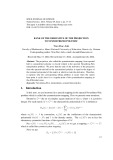
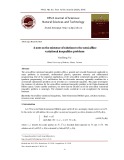
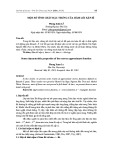
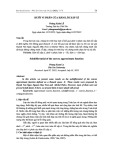











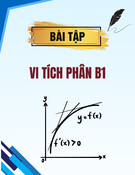



![Quyển ghi Xác suất và Thống kê [chuẩn nhất]](https://cdn.tailieu.vn/images/document/thumbnail/2025/20251030/anh26012006/135x160/68811762164229.jpg)
